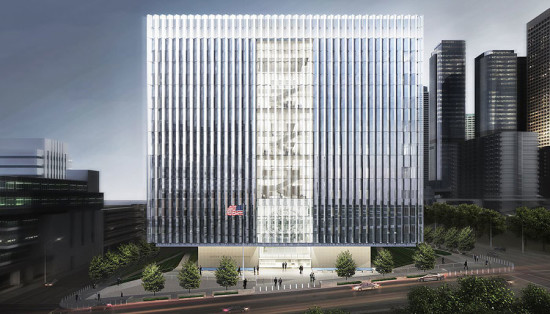
The building’s pleated glass envelope contains 1,672 energy efficient panels that uniquely responds to its location.
SOM has floated a glass cube above a large stepped civic plaza negotiating a sloped site in downtown Los Angeles for their United States Courthouse project, scheduled to open July, 2016 with an anticipated LEED Platinum rating. The 633,000 square foot, 220 foot tall facility includes 24 daylight-filled courtrooms and 32 judges’ chambers.
José Luis Palacios, Design Director at SOM Los Angeles, says this structural configuration was integral to the success of the project: “Our challenge was how to make a transparent building, both metaphorically and structurally.”
The project is being labeled as one of the nation’s safest buildings in regards to bomb threats and earthquakes due to an innovative structural engineering concept which allows a large volume of building to “float” over a stone base protected with hardened-concrete shear walls. The outer 33 feet of cantilevered building is suspended from a three-dimensional steel “hat truss” system, freeing the need for columns at the perimeter and ground level. The trusses are efficiently designed through an optimization process which resulted in a material savings of over 13 percent when compared to conventional trusses.

- Facade Manufacturer
Benson Industries, LLC - Architects
Skidmore, Owings & Merrill LLP - Facade Installer
Benson Industries, LLC - Facade Consultants
Skidmore, Owings & Merrill LLP, Clack Construction Group (client/construction manager) - Location
Los Angeles, CA - Date of Completion
July 2016 (projected) - System
High-performance unitized glass panels - Products
Viracon Glass
The facade is comprised of a unitized 6’ wide by 20’ tall panel, organized into a ‘pleated’ zigzagged surface. By reconciling the downtown Los Angeles street grid, which runs 38 degrees east of true north, with optimum solar angles, the facade managed to reduce solar heat gain, harvest natural daylight, and maximize views into and out of the building. The pleating of the facade allows for a reduction in the radiant heat load of the building by 47 percent compared to a flat surface.
Signage to the building is applied as a ceramic frit pattern to the glass of the pleated facade. The two-dimensional graphic, the ‘Great Seal of the United States,’ is projected onto the three dimensional facade, reinforcing the civic plaza and a frontal approach to the main entrance.
As a result of the pleating, facade panels were broken down into two types: a “hot panel” and a “cold panel” side. Additional variation was introduced through internal program requirements, such as the Broadway and Hill Street facades where courtrooms consists of three internal layers of shades help to manage daylight from both sides of the courtroom.
The modular, shop built assembly of panels is something Palacios says SOM is incorporating into an increasing amount of their projects today: “This gives us long-term durability, and seismic responsiveness: a great flexibility and resiliency.”






